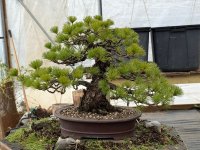Are you basing this off needle color? or something else.
Nice tree! I've had a few JWP in various stages of development over the years, however they were all grafts. Needle color was darker when comparing to ungrafted trees.
I was never able to get any decent backbudding on any of mine but hopefully you have better luck.
Ungrafted JWP has been on my wish list for a while, virtually impossible to find here in the US!! I still kick myself for not getting one of Julian Adams years back when i had the chance.
Looking forward to your updates, we all know it's in good hands!
It has Japanese white pine bark all the way down to the soil line.
There are three reasons I think the tree is on its own roots.
1) As
@Bonsai Nut noted, the JWP bark goes all the way down to the soil. Generally, there is a distinct difference in bark texture above and below the graft union. This is pretty definitive, but not 100% because a skilled grafter can place the graft union very low so the soil level will hide it. However, having repotted this tree, I happen to have had an opportunity to look at the trunk and surface roots below the soil line, so I’m pretty sure it’s a seedling rather than a grafted tree. This is the most important reason.
2) Seedling JWP tend to be less vigorous than grafted JWP. This tree seems healthy, but not vigorous. Not at all definitive, but at least consistent with #1.
3) Grafted JWP usually have a blue tinge to the foliage rather than the yellow tinge of the non-grafted JWP. The foliage of this tree is distinctly yellowish. Again, not at all definitive, but stronger evidence than #2 and consistent with #1.
Taken together, I feel pretty confident that is a seedling JWP. It’s also pretty old - JWP tends to have smooth bark when young and it can take a few decades for the flaky plates to appear, especially if the tree is on its own roots. This tree has old, plated bark indicating that it may be at least 30-40 years old.
That’s my understanding anyway, but there are lots of folks here who have more experience with JWP than myself. I’ve worked with them at Boon’s quite a number of times, but that’s different than having them in your garden. They were definitely out-of-range in Houston, so I never grew them there.
- S






